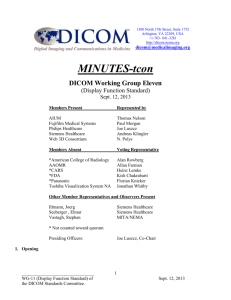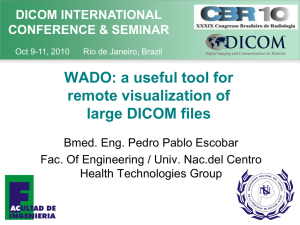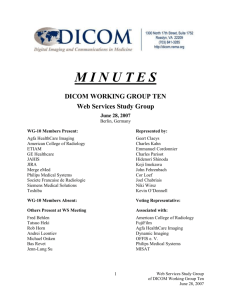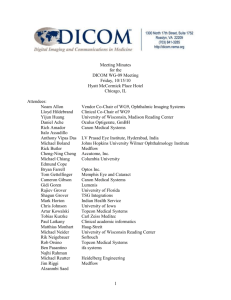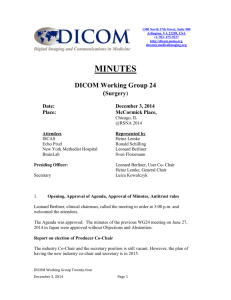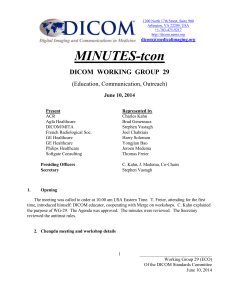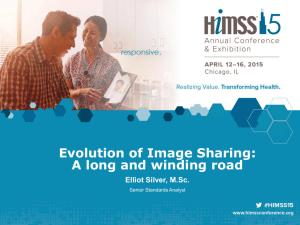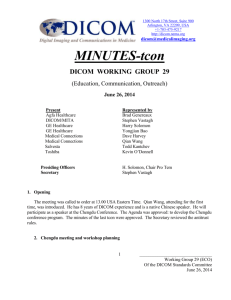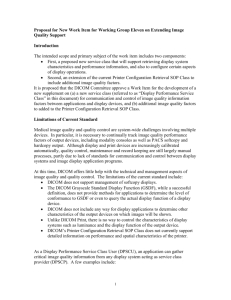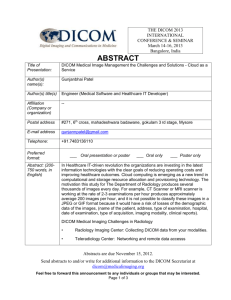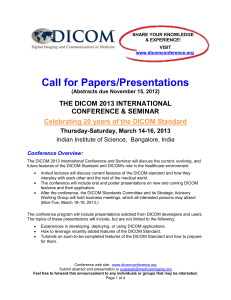WG-09-2014-10-17-Minutes - dicom
advertisement
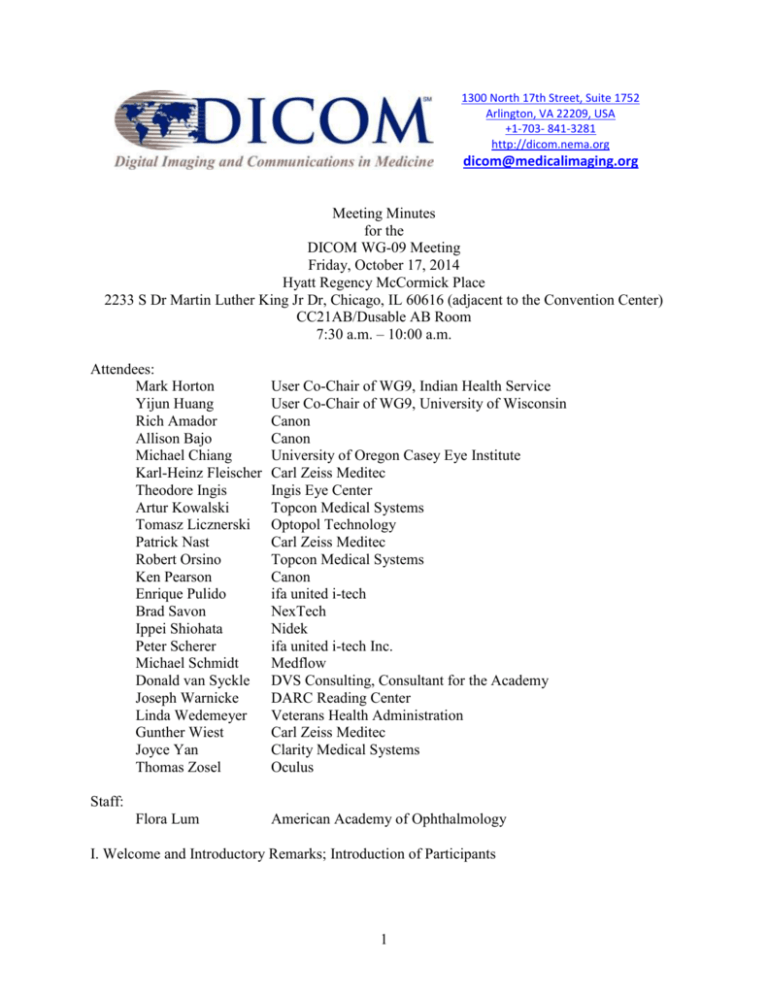
1300 North 17th Street, Suite 1752 Arlington, VA 22209, USA +1-703- 841-3281 http://dicom.nema.org dicom@medicalimaging.org Meeting Minutes for the DICOM WG-09 Meeting Friday, October 17, 2014 Hyatt Regency McCormick Place 2233 S Dr Martin Luther King Jr Dr, Chicago, IL 60616 (adjacent to the Convention Center) CC21AB/Dusable AB Room 7:30 a.m. – 10:00 a.m. Attendees: Mark Horton Yijun Huang Rich Amador Allison Bajo Michael Chiang Karl-Heinz Fleischer Theodore Ingis Artur Kowalski Tomasz Licznerski Patrick Nast Robert Orsino Ken Pearson Enrique Pulido Brad Savon Ippei Shiohata Peter Scherer Michael Schmidt Donald van Syckle Joseph Warnicke Linda Wedemeyer Gunther Wiest Joyce Yan Thomas Zosel User Co-Chair of WG9, Indian Health Service User Co-Chair of WG9, University of Wisconsin Canon Canon University of Oregon Casey Eye Institute Carl Zeiss Meditec Ingis Eye Center Topcon Medical Systems Optopol Technology Carl Zeiss Meditec Topcon Medical Systems Canon ifa united i-tech NexTech Nidek ifa united i-tech Inc. Medflow DVS Consulting, Consultant for the Academy DARC Reading Center Veterans Health Administration Carl Zeiss Meditec Clarity Medical Systems Oculus Staff: Flora Lum American Academy of Ophthalmology I. Welcome and Introductory Remarks; Introduction of Participants 1 Dr Horton and Dr. Huang welcomed the participants. Everyone introduced themselves and their affiliation. II. Review of Meeting Agenda The group approved the agenda without additions. The group was also informed of the new WG-06 summary on the DICOM Home Page. ‘DICOM News.” An announcement was also made that nominations, including self-nominations, were invited for a VendorCo-Chair position. III. Review of Antitrust Rules The group reviewed together the Antitrust rules provided as an agenda attachment. III. Review of Previous Meeting Minutes The minutes of the November 15 2013 WG9 meeting in New Orleans were reviewed. These have already been approved by DICOM. WG-09 affirmed the election M Horton and Y Huang as Clinical Co-Chairs. III. Major discussion items: A) Review of progress since November 2013 1. Supp 173 Wide Field Ophthalmic Photography Image Storage SOP Classes, Donald Van Syckle Mr. Van Syckle described the origin and progress of Supplement 173. Last year, the WG determined that there was a valid use case for a new supplement and initiated a work item and workgroup. The major impetus was that the current OP supplement would not provide accurate measurements for wide field fundus images. The supplement should provide for accurate and reproducible measurements. The supplement was approved for Public Comment in September 2014, and individuals were urged to review and provide comments before the end of the comment period. The timeline for 2015 is expected to be achievement of Letter Ballot in January 2015, and hopefully, achievement of Final Text in March 2015. 2. Discussion on Supp 130 Ophthalmic Refractive Measurements Storage and SR SOP Classes, Artur Kowalski Mr. Kowalski had described the difficulties with DICOM standard implementation previously last year. These were the chief problems encountered: lack of patient demographics information in the devices’ output; partial incompatibility of the SOP classes with the actual output of Topcon devices; and lack of other systems supporting this type of DICOM object because of the overhead involved in DICOM implementation for small devices without significant computing capability. Many do not support the 2 input of patient data, so they cannot produce results that include patient demographics. There are several potential options that could be considered, including combination of refractive data devices that address more than one of the SOP classes, creation of devices with patient data input capabilities, device enhancements allowing patient data to be “injected” into the stored exam data, and using Acquisition Modality Importers to match legacy device output with the proper patient data. Issues related to support of the standard include: reallife implementations have not been identified by EHRs, EHR systems typically implement custom interfaces to integrate legacy devices, and other approaches using XML by the JOIA in Japan. Potential solutions include the modification of the DICOM standard or choice of a different mechanism to store refractive data, such as the General Eye Evaluation c-CDA, which has a comprehensive listing of refractive data elements. Increased adoption of DICOM and HL7 have been shown suitable for exchange of medical information, and the Modality Worklist would address the issue of not having to input patient data. There is growing market demand for uniform data representations, and government regulations will favor solutions based on established standards. In addition, institutions are now asking for all data to be stored in archives or PACS, including the refractive data. The Working Group 9 discussed the various concerns and options. The Working Group voted to pass this item for IHE Eye Care Planning Committee to consider. 3. Discussion of color eye model subgroup of the medical imaging workgroup DICOM staff forwarded WG9 information about a Medical Imaging Workgroup of the International Color Consortium developing a color eye model. The impetus was that the FDA has identified that there is a lack of standardization of color in medical imaging, and that this might affect the reliability of diagnosis, thus having an impact on patient safety. There does appear to be variability across individual observers in color interpretation, as well as variability from the beginning to the end of the imaging process with issues of illumination, and other issues not under control of the physician or device manufacturer. Despite this variability in the process, there might be ultimate benefit in color calibration for future computer-aided diagnosis. The workgroup has requested clinical input in the form of images to identify the key colors that then could be used for calibration, in order to provide consistency and reproducibility. Rich Amador will ask the chair of the Color Model Eye Working Group exactly what input is requested. The Working Group 9 determined that this was an important concern, and referred this to the Academy to provide clinical input as appropriate. At this point in time, there is no action relevant to the DICOM Working Group 9. 4. How to increase implementation of DICOM standards 3 The Academy has been working to advocate the identification of DICOM standards for ophthalmology, similar to what was proposed for radiology and cardiology, within Meaningful Use criteria in order to increase implementation. The Academy recently met with staff of the Office of the National Coordinator to continue its support for DICOM standards in the Meaningful Use Stage 3 criteria. It seems that the federal government is concerned about the interoperabiloity of imaging and electronic health records, and the need to associate correct patent demographics with the imaging, which DICOM can address. IV. New work items A) The group discussed past topics, Wavefront, and Glaucoma Structured Report, but there were no volunteers. No other new work items were proposed. V. Next Meetings of the Working Group 9 A) Friday, November 13 2014, Academy Annual Meeting, Las Vegas Reported by: Flora Lum, Secretary October 17, 2014 Reviewed by counsel: 4

